When I first saw Andrea Bergen's Joshua Tree, I thought it was a painting. When I got closer I realized it was a collage. I couldn't believe it was a collage. Who is Andrea Bergen and how is she making these gargantuan collages?
While Joshua Tree was being shown in ArtSpan's "Germinate" exhibit in SOMA, another of her works, Parking Lot, was on display as part of the Santa Cruz Art League’s 88th Annual Statewide Landscape Exhibition. As good a reason as any to head to Santa Cruz.
Passed paintings of sand dunes and wildflowers, in the very back of the exhibit, near the EXIT sign, was Ms. Bergen's colossal Hieronymus Bosch-like collage Parking Lot. In it, raccoons have crashed a car into a brick wall of a big box store. Dogs stand in a circle on their hind legs while two companions are beamed up into a UFO. A possum grimaces in the foreground while baby possums along with baby aliens cling to her fur. A full-size alien is just about to pass out in a shopping cart center frame. His glowing finger á la E.T. reaches for a rat that sits on his chest and in the other hand he absentmindedly dribbles a bottle of DeKuyper® Pucker® Grape Schnapps Liqueur on to the ground. Wait, Purple Schnapps is a thing? No time to dwell. There is a friendly dog pushing the shopping car with the drunk alien inside of it. The dog looks happy even though the store behind him is on fire. A pigeon triumphantly holds up a Cheeto while a nearby dog does his business while furtively looking over his shoulder. Did all those bats come from inside the Winnebago that is on fire?
I thought, I LOVE THAT THIS COLLAGE EXISTS IN THE MIDDLE OF ALL THESE PRETTY BEACH LANDSCAPES.
I also thought, is Andrea Bergen laughing at me, the Viewer, right now? She graciously agreed to an interview and I still have no idea.
How much planning goes into a collage that is nine feet across?
The collages all started from sketches. They were created with graphic designer Tetsuya Takenomata. He was responsible for much of the composition for the twelve panels. Together we created the story, which was a progression from forest to parking lot. Once we decided upon the scenes and animals we wanted to include, I sketched them out in colored pencil. Tetsuya then created mockups in Photoshop using reference photos. I used these mockups to draw pencil sketches onto the wooden panels. After making these initial sketches to block out the composition, I cut out the paper freehand using the computer images as reference.
How long does it take to create a large scale collage like Joshua Tree or Parking Lot?
Joshua Tree and Parking Lot are part of a group of four triptychs. The entire piece is comprised of twelve 3-by-4 foot panels. The whole project took about four months to complete.
What does working so large give you that you can’t get working at smaller dimensions?
It's interesting to take collage to the large scale that people expect of a painting. We are used to seeing small intricate collages rather than installation style pieces. Technically, it is much harder for me to achieve my desired level of detail when I am working too small. I need the large scale to accommodate all the layers and fine details. The large scale also creates an immersive viewing experience that is harder to achieve with a smaller piece.
We are used to seeing small intricate collages rather than installation style pieces.
Do you use special scissors or stencils to make intricate, repetitive shapes?
Tetsuya ordered special scissors for me from Japan called Swing Cut. They stay sharp longer than any other scissors I’ve tried. I don’t use a stencil, X-ACTO knife or miniature shears for details. I don’t like switching tools. Everything from large to small pieces are cut with the same pair of scissors.
What type of paper do you use?
I use colored pastel paper. I have my palette set out and pick colors as I need them. I have tons of scraps I’ve collected and I’m still figuring out what to do with them.
Do you have a studio space?
For two and a half years, I worked in an apartment in Oakland with Tetsuya. We created many large scale pieces in this small room. I had to get creative to accommodate the 3-by-4 foot panels and even became accustomed to working upside down at times. I now have a studio in San Francisco and am experimenting with Papier-mâché sculptures.
Do you prefer working alone or with others?
I prefer to work alone, but greatly enjoy having other artists around to bounce ideas off of or get inspiration from. I think it's important to be amongst peers. My studio in San Francisco has 25+ artists in it and we are going to participate in open studios together this fall.
Do you listen to anything while you work?
I have several comedy podcasts I enjoy listening to: Doughboys, Threedom, Comedy Bang Bang, Uhh Yeah Dude, Who Charted, Yeah But Still. The talking keeps me distracted enough to keep working for long hours. My mind wanders too much if I’m listening to music.
Were you encouraged to make art from an early age?
I attended a school with an excellent arts program from kindergarten on. Even before that, I was always drawing and painting. My grandmother was a fine artist and I fondly recall making crafts with her. However, I owe most of my desire to be an artist to my elementary school art teacher, Mr. Hershcopf, who was a beloved figure at school. He encouraged me to continue developing my skills.
Did you always feel like you wanted to be an artist? Did you ever consider other careers?
I am very fortunate to come from a family that supports my artistic aspirations. They pushed me to pursue a fine arts education. I sometimes wish I had the structure of an office job, however, I’m terrible at everything except for collaging. I briefly flirted with the idea of becoming a nurse. I am still working towards my goal of fully supporting myself financially purely from sales of my artwork. I’d like to work at a museum in some capacity.
What was your experience of going to art school like?
I enjoyed my time at California College of the Arts. Probably the best thing about it was that I didn’t feel pressure to conform to anyone else’s ideas about what an artist should be like or do. I felt freedom to pursue my own interests and knew I would have the support of the faculty and my classmates in whatever avenue I chose. Some of the best times I had were in the painting studios late at night working with my friends around.
Was there a particular art assignment from school that you remember as being key to your evolution as an artist?
Working on my senior show gave me the drive and desire to push the limits of my painting. I was working very large, at least 8-by-8 feet, and created four huge tapestry-like, colorful, figure filled, Pop art inspired paintings. Having a show was excellent motivation for creating ambitious pieces.
Parking Lot by Andrea Bergen
How did you come to your unique painterly style of collage making?
The experimentation with collage began out of a necessity. I was traveling and needed to create work for an assignment and didn’t want to make a mess by using paint. When I started cutting and pasting it felt different from painting, in a good way. It was a more immediate medium and ideal for me, because I wasn’t a fan of mixing colors or waiting for paint to dry. Collage allowed me to work more quickly and get the opacity and graphic quality I wanted out of the paint. I enjoyed seeing the development from blocky, rough early experiments into densely layered, detailed pieces. After I graduated I again began collaging out of necessity, because I had a sublet studio.
Name some artists you really like.
Matt Furie, Elisheva Biernoff, Eric Yahnker, Paul Wackers, Moira Hahn, Ryan McGinness, Andrea Joyce Heimer, Kim Dorland, Casey Gray, Hilary Pecis, Robert Minervini, Sean Norvet, Michelle Blade, Robert Xavier Burden, Jeff Gillette, Jave Yoshimoto
Has living in Oakland strongly influenced you as an artist?
I grew up in the Oakland Hills surrounded by nature and this fostered my love of animals and my sensitivity to the environment. I was also exposed to a wide variety of art styles through Oakland's museums and street art. My collages are a stylistic soup influenced by movements such as Pop art and Surrealism as well as various trends in Contemporary art.
What do you draw inspiration from?
A lot of the inspiration for my recent body of work has come from extremely depressing news about environmental degradation. It appears we have passed the tipping point of being able to reverse climate change. The future seems overwhelming and terrifying to think about. The collages are an outlet for this anxiety. I like to imagine a future in which humans go extinct and wildlife is able to regain control of the planet.
When I don’t know what to add to a collage, I usually throw some snacks in.
What’s your relationship with junk food?
I’m obsessed with junk food, but try not to eat it, so it goes into the collages. It is part of the juxtaposition of the unnatural with the natural world. A raccoon eating Cheetos shouldn’t exist, but that’s the environment we’ve created. Junk food also has the best colors, colors that fit my Technicolor palette. When I don’t know what to add to a collage I usually throw some snacks in.
What are the animals in your work feeling?
They are celebrating their freedom from people and retaking the earth for themselves. I think of the animals as wild, but they have been transformed by human intervention. They have adapted to our trash and food and make use of things we've left behind. When they have full reign of the planet they can raid Walmart and eat all the delicious crap they want without consequence.
What prompted you to enter the Santa Cruz Art League’s 88th Annual Statewide Landscape Exhibition?
I applied to the show because the pieces thematically fit the description of “California landscapes,” but are technically very different from typical landscape paintings. Also, I love visiting Santa Cruz and wanted an opportunity to expand my audience.
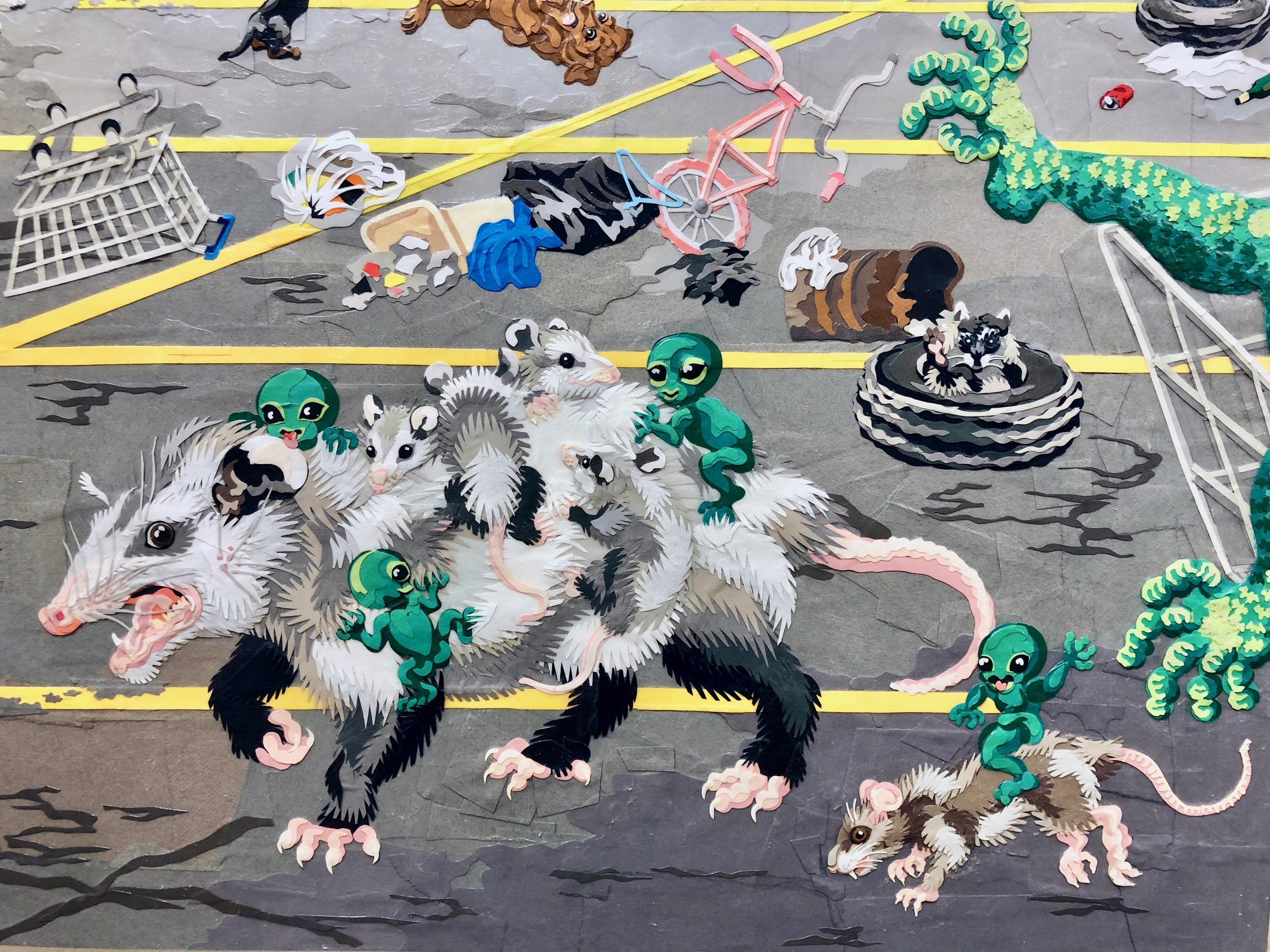
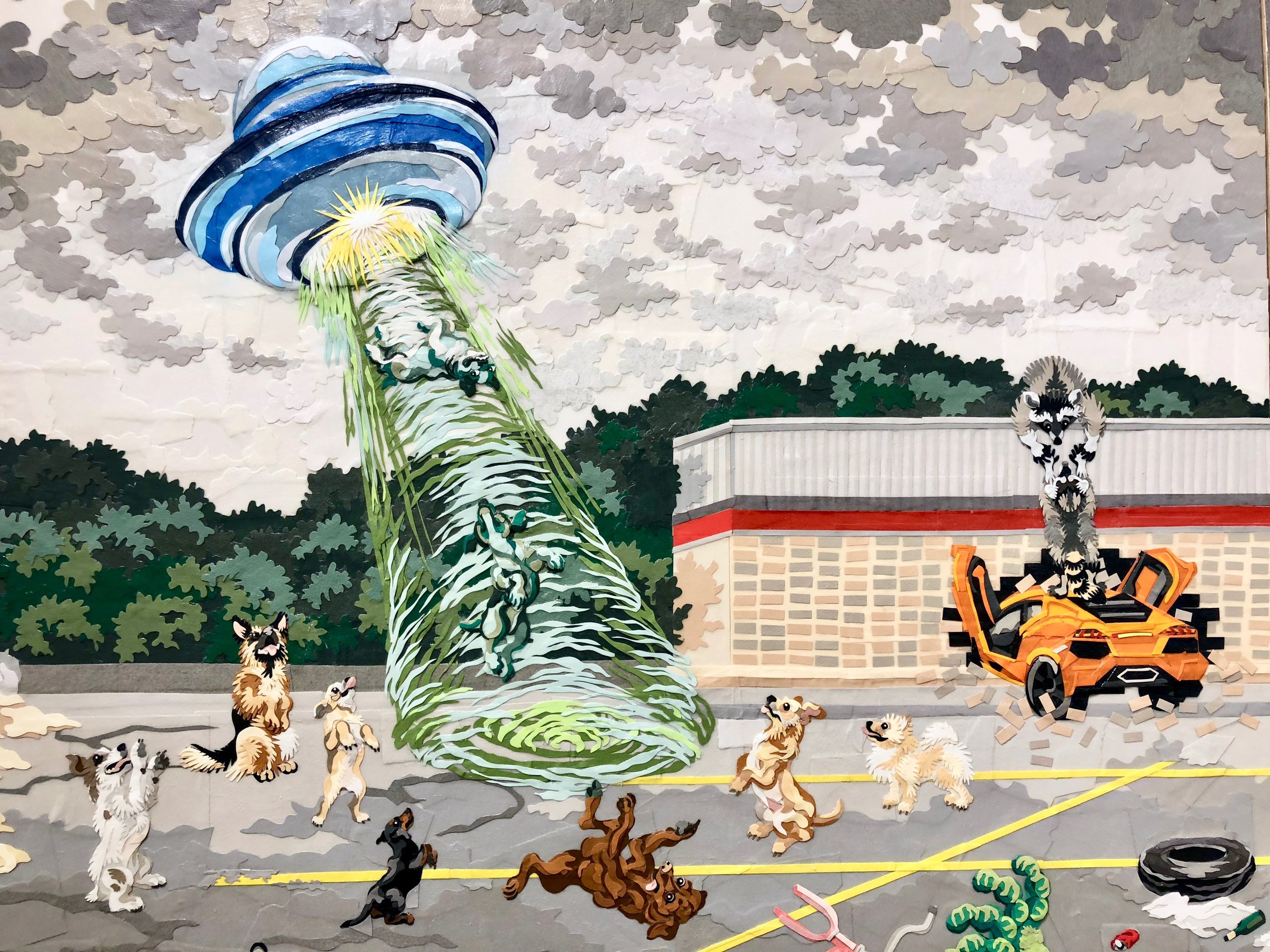
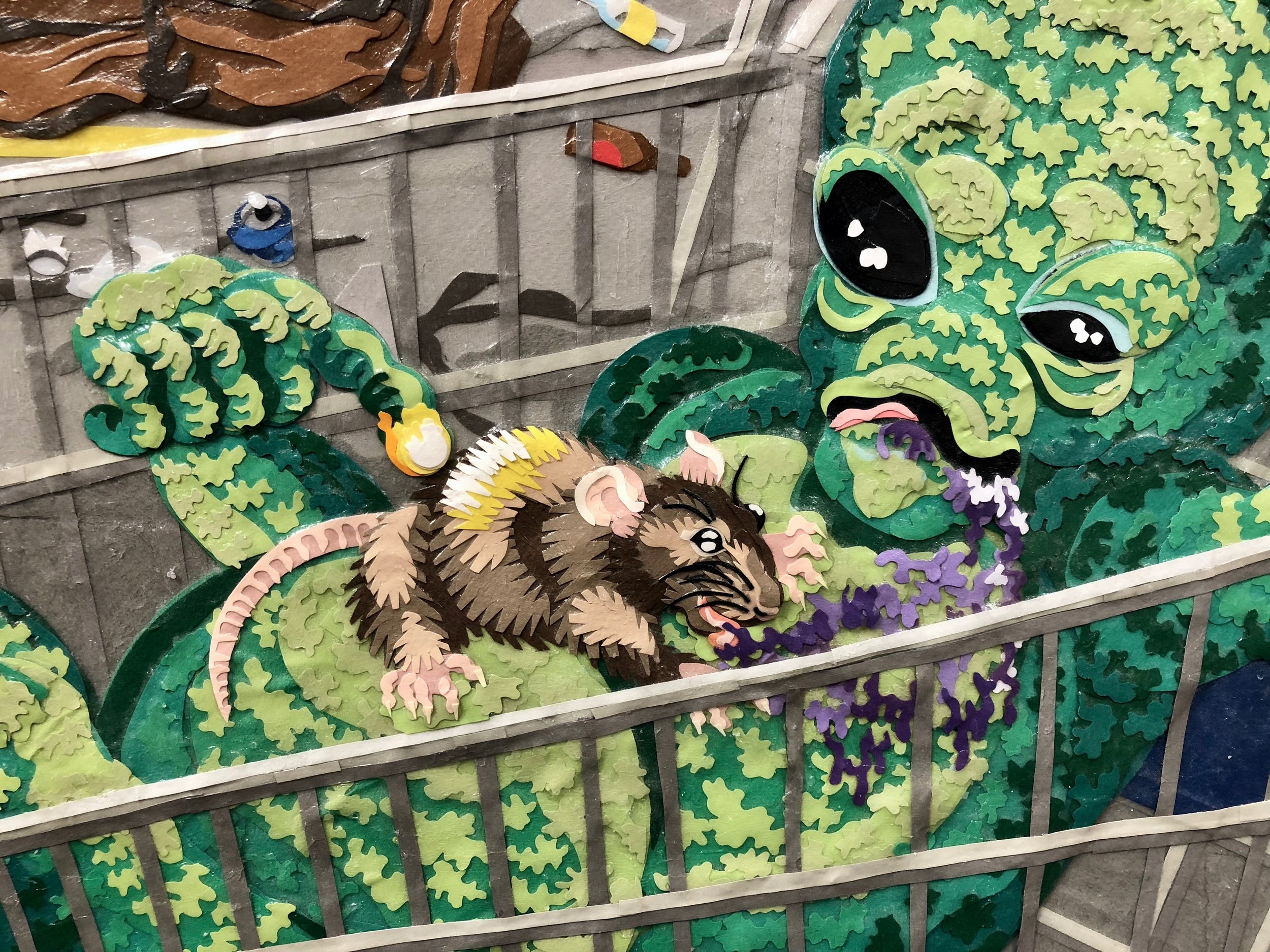
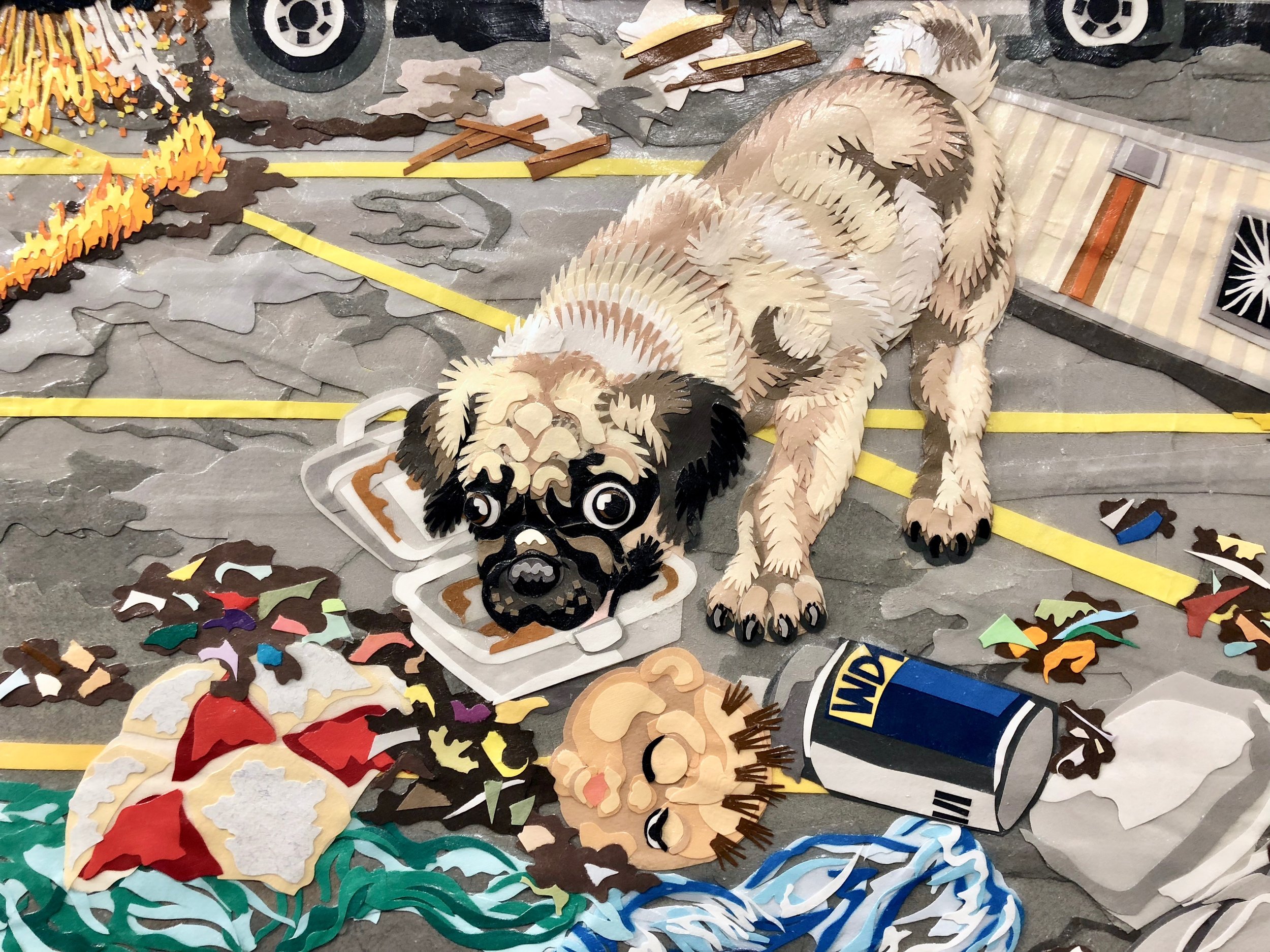
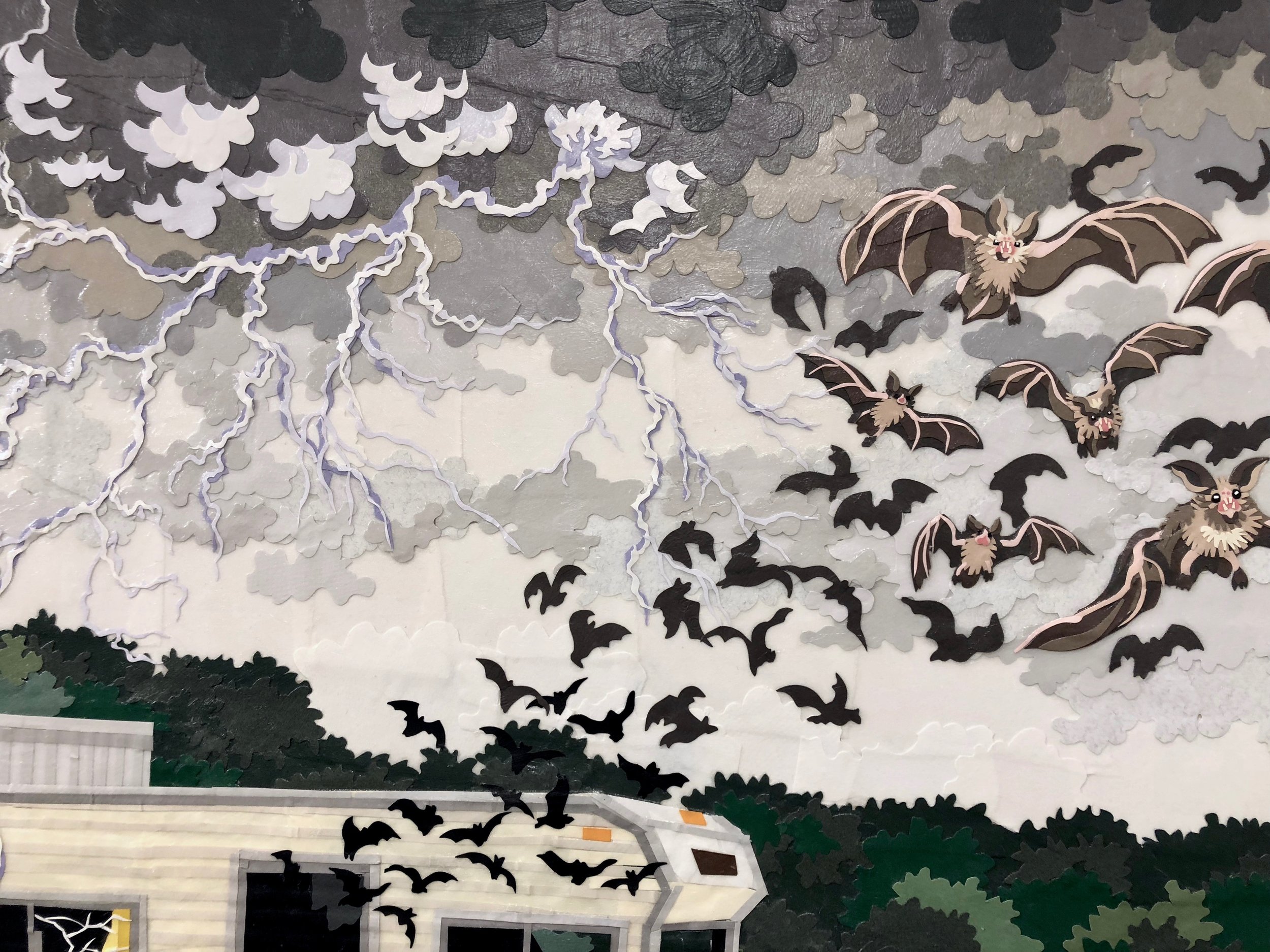
See more of Andrea Bergen's work here: http://www.andreabergen.com/



